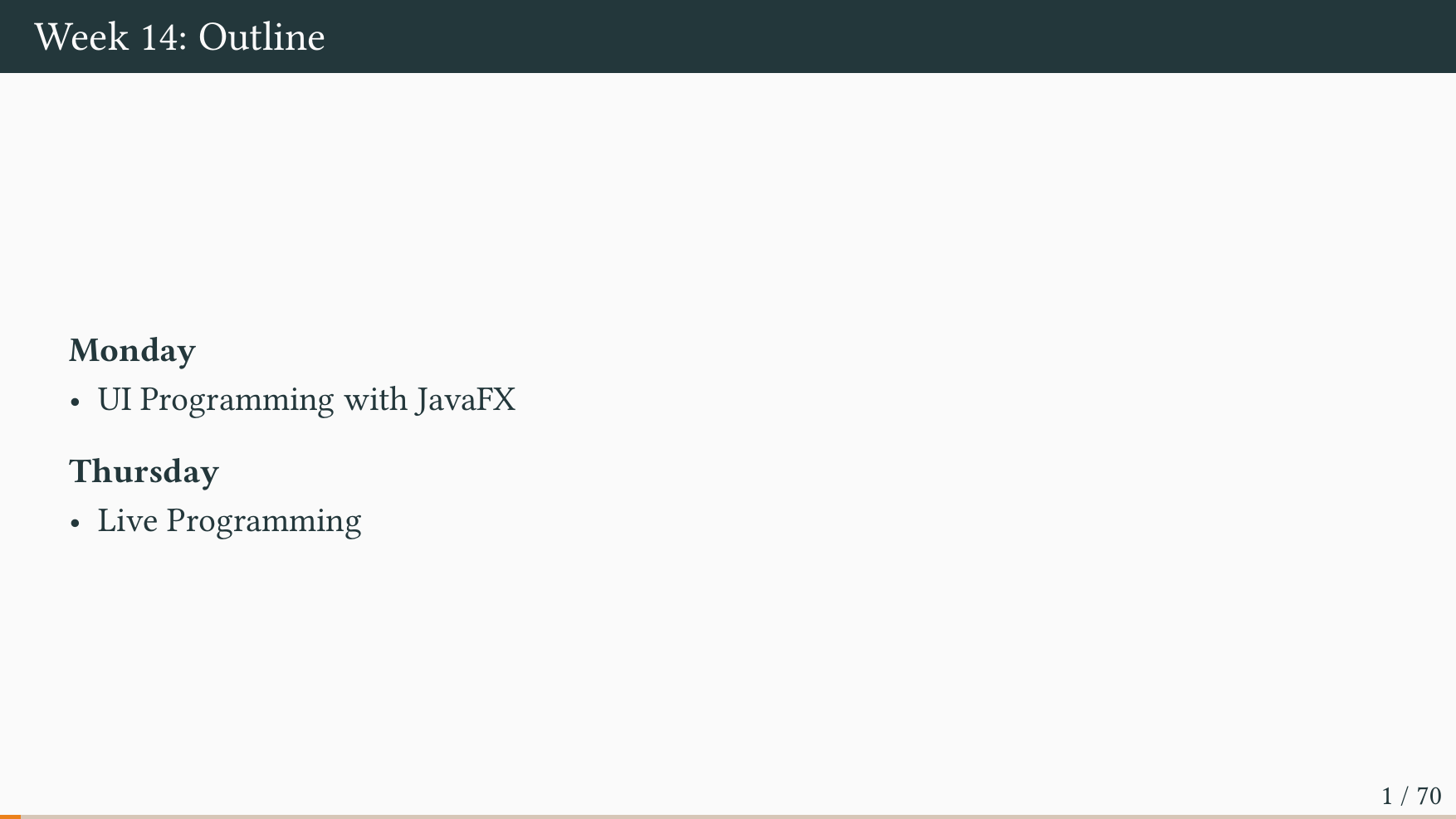Week 14 (Reading | Slides | Exercises)
Reading (Mandatory)
Additional Material (Optional)
Slides
Exercises
Exercise 14.01: Explain, in your own words, the concepts of a stage and a scene.
Exercise 14.02: Explain, in your own words, the role of the Application
class in JavaFX.
Exercise 14.03: Write an application that has a window with the title Hello World!, and a width and height of 800 times 600 pixels.
Exercise 14.04: Experiment with the following methods on the Stage class:
setOpacity, setAlwaysOnTop, setFullScreen, setMinWidth, and
setMaxWidth. Do these methods behave as you would expect? If not, try to find
out why.
Exercise 14.05: Experiment with the following methods on the Scene class:
setCursor and setFill. Add event handlers with setOnMouseClicked and
setOnKeyPressed. The event handlers should print some text to the terminal.
Exercise 14.06: Write an application with a single button with the text
Click Me! When the button is clicked, change its text to You Clicked! and
disable the button.
Exercise 14.07: Write an application with a label and a button inside a
horizontal box. When the button is clicked, change the text of the label to You Clicked!
Exercise 14.08: Write an application with nine buttons numbered from 0 to 9 (similar to the dialpad on a mobile phone). Layout the buttons using either horizontal and vertical boxes, or using a grid.
Exercise 14.09: Write an application with a textfield and a button. When the button is clicked, the text in the textfield should be capitalized.
Exercise 14.10: Write an application with a button. When the button is
clicked, show an alert with the text You clicked the button!
Exercise 14.11: Write an application with a text field and a password field. Add a button that when clicked checks whether the username and passwords are correct.
Exercise 14.12: Write an application with three radio buttons labeled Red,
Green, and Blue. When a radio button is selected, change the background color
of the scene to the corresponding color.
Exercise 14.13: Write an application with a progress bar and a button. Each
time the button is clicked, increase the progress bar by 10%. When it reaches
100%, display an alert saying Task Complete! and reset the progress bar to 0.
Exercise 14.14: Write an application with a large text area and two labels.
One label should display Words: X and the other should display Characters: Y, where X and Y are the counts of words and characters in the text area. The
labels should update automatically as the user types.
Weekly Hand-in
Write a graphical user interface for a simple calculator application.
Here are some steps to get started:
- Add a label to show the currently entered number.
- Use horizontal and vertical boxes, or a grid, to construct a layout of buttons numbered from 0 to 9.
- Add buttons for addition, subtraction, multiplication, and division.
The calculator should work as follows: You press "5", it shows up in the display, then you press "+", and then you press "7" and it becomes "12".
Hint: Experiment with the calculator on your system to discover how it works.
Here are some optional extensions to consider:
- (optional) Style the label to make the result bigger.
- (optional) Style the digit buttons so they are bigger.
- (optional) Add an event handler such that user can press the keys 0 to 9 on the keyboard with the same effect as using the buttons.
- (optional) Add a try-catch block to detect division by zero and show an appropriate alert message.
- (optional) Add an event handler such that the escape key resets the calculator.
